Canon PowerShot SX1 IS Review
Canon PowerShot SX1 IS
With 10 megapixels, 20x zoom and HD video recording, the SX1 IS has it all.
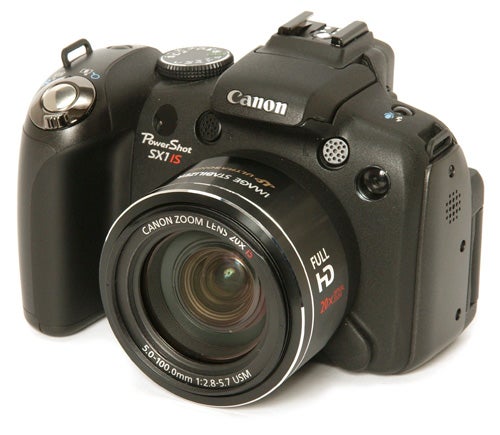
Verdict
Key Specifications
- Review Price: £370.00
Two weeks ago I reviewed the PowerShot SX10 IS, one of a pair of new super-zoom bridge cameras that have replaced the popular S5 IS in Canon’s digital camera range. Today I’m taking a look at the SX10’s slightly smarter sibling, the SX1 IS. Like the SX10 it is a 10-megapixel super-zoom camera featuring a 20x wide-angle zoom lens, but it improves on the cheaper model’s specification in two important ways. First, it has a faster CMOS sensor, giving it a faster continuous shooting speed, and second, it can shoot video in full 1080p HD format.
Naturally these extra features push the price up somewhat. The SX1 is currently available for about £370 from discount online sellers, although you’re more likely to see it for around £400. That’s a lot of money for a compact camera; in fact it’s one of the most expensive non-SLR cameras on the market, costing around £30 more than the PowerShot G10, and about £50 more than the Panasonic LX3. It’s also more expensive than most entry-level digital SLRs, so the obvious question is whether or not it’s worth the money.
Not only is the SX1 priced like an SLR, it’s built like one too. The body is almost identical to that of the SX10, which in turn is very similar to its predecessor the S5 IS. It’s a large and surprisingly heavy camera, measuring 127.5 x 88.3 x 87.7 mm and weighing approximately 585g, slightly wider, taller and heavier than the SX10. For comparison, an EOS 450D digital SLR weighs 475g (body only).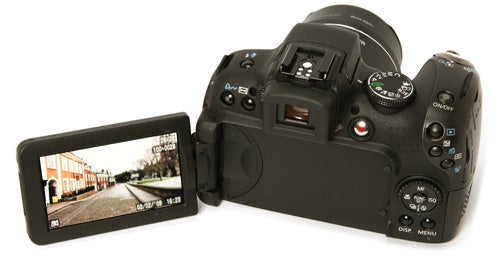
Build quality is, as you might expect for that sort of price, very good. The body is tough plastic with a curvy shape that is inherently strong, and the lens surround is aluminium. The camera is solidly made and feels like it could take a bit of rough treatment without complaining too much. All the controls are securely mounted and the battery and card hatches have strong metal hinges.
The range of features that the SX1 offers is pretty much identical to the SX10. It has a full selection of manual exposure options, with a good shutter speed and aperture setting range, as well as a number of scene modes, including so fun creative options such as colour swap and colour accent. Main mode selection is via the big dial on the top panel, but scene mode selection is done via the rotary bezel around the D-pad. Unfortunately this control is horribly clumsy, making selection of the required scene mode frustratingly slow and fiddly as you nudge the bezel backwards and forwards trying to get it to stop on the one you want. I don’t know why Canon still insists on using these unpleasant rotary controls for things for which they are patently unsuitable when a perfectly normal menu and D-pad would do the job twice as well.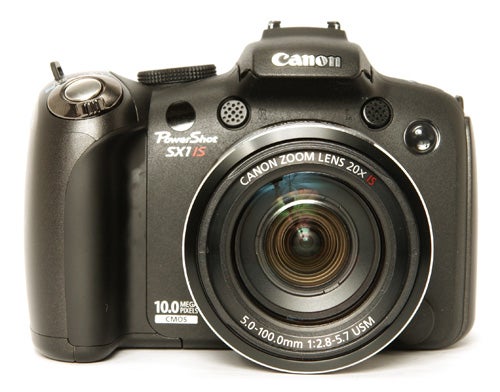
One of the differences between the SX1 and the SX10 is the LCD monitor. The SX1 has a 2.8-inch widescreen monitor, which takes up more room on the back of the camera, which means that the rear controls have had to move over to make room, but perversely this has actually helped, since the top of the D-pad is no longer right under you thumb when shooting.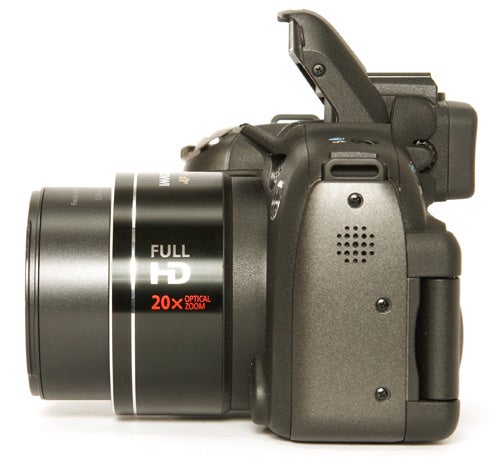
The screen itself, although physically larger, has the same 230k dot resolution as the SX10, and is just as bright. The SX1 also has an electronic viewfinder, but herein lies a small mystery. The official specification of the SX10 states that it has a 235k resolution EVF, but as I mentioned in my review it appears to be very coarse, with the dots plainly visible, and far too low-res for manual focusing. The same is unfortunately true of the viewfinder on the SX1, but the published specification both on Canon’s website and in the camera manual state that the resolution is only 148k dots, which would make more sense, and makes me think that the resolution stated in the SX10’s specification is a misprint.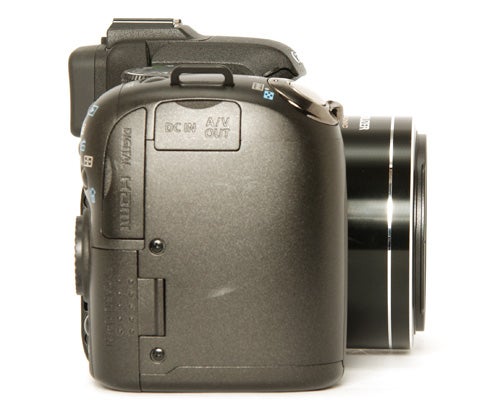
The SX1’s main selling pint is of course its HD video mode, and it has to be said that this really is very good. It’s probably the closest that any still camera has yet come to matching the performance of a dedicated camcorder. It can shoot in full 1920 x 1080 resolution at 30fps, with clip length limited to a second shy of half an hour or 4GB file size, and in 640 x 480 mode it can shoot for an hour. Thanks to the almost silent ultrasonic motor the zoom lens can be used while shooting, and still images can also be captured during filming. The movie quality is excellent, certainly good enough for all your home movie needs, and the sound quality too is superb. The camera has high-quality stereo microphones mounted above the lens.
The combination of Canon’s proprietary CMOS sensor technology and DIGIC 4 processor is intended to give the SX1 faster overall performance than the SX10, and it seems to have succeeded. Both start-up and shut-down times are comfortably under two seconds, which is impressive considering the size of the lens that has to be rolled out. The SX1 has the same single-point AF system as the SX10, and it too is impressively fast, resulting in a very quick single-shot cycle time of 1.4 seconds.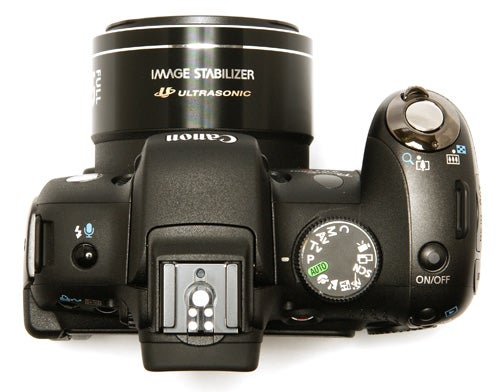
Some people seem to attach great significance to continuous shooting speed, which is odd considering how rarely it is actually useful. However Canon makes quite a big thing of the SX1’s continuous mode, because it can shoot at four frames a second. This is indeed very impressive, considering the amount of data that is being processed and stored, but in this high-speed mode that camera doesn’t focus between shots, so it’s not particularly useful for moving subjects. It also has another continuous mode that includes motion-tracking AF, which is a lot more useful but somewhat slower, shooting at approximately 1.25 frames a second.
I’m not sure that the increase in continuous mode performance has been worth it, because I was somewhat surprised to find that the CMOS sensor seems to have sacrificed picture quality for shooting speed. At lower ISO settings there is no problem, and the camera performs brilliantly. I took a number of photos during the recent snow, a situation which can cause exposure and white balance problems for some cameras, but the SX1 coped perfectly, producing nice clean whites and clear accurate colours. It also performs well in low light, focusing quickly and accurately, and the iContrast feature is very good at capturing a nice balance between shadow and highlight detail in high-contrast conditions.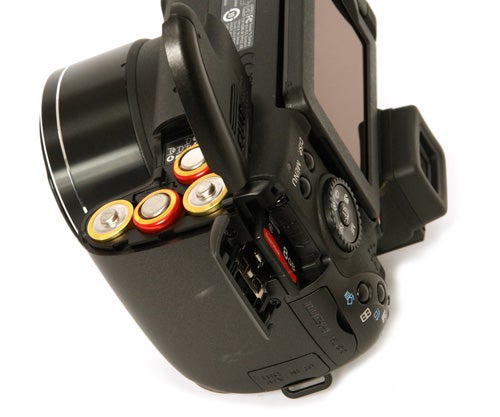
The problems only really start at about 400 ISO. Perhaps it’s a feature of small CMOS sensors, but at higher ISO settings there were major problems with image noise, including what looked a lot like hot pixels. This is very surprising, since Canon cameras generally have excellent noise control. Fortunately the maximum ISO setting in normal mode is only 1600, so things don’t get too messy, although there is high-ISO scene mode that pushes it up to 3200, with predictably horrible results.
”’Verdict”’
The PowerShot SX1 IS comes closer than any other compact still camera to matching the video capabilities of a dedicated HD camcorder, and no doubt there are some people out there who will find the 4fps continuous mode very useful for something or other, but the loss of high-ISO picture quality is a sacrifice few will be willing to make, especially on a camera costing nearly £400.
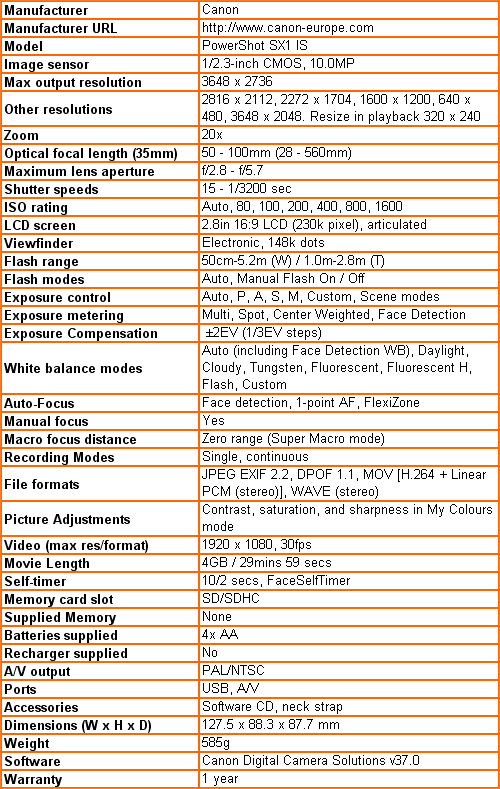
”Over the next few pages we show a range of test shots. On this page the full size image at the minimum and maximum ISO settings have been reduced to let you see the full image, and a series of full resolution crops have taken from original images at a range of ISO settings to show the overall image quality. ”
—-

This is the full frame at 80 ISO, the minimum setting.
—-

At 80 ISO the image quality is very good, with no visible noise, although there are some red fringes around the bright gold areas.
—-

Already at 100 ISO there is a little noise appearing in the mid-grey areas at the top left of this crop.
—-

At 200 ISO there are a couple of individual “hot pixels” showing, as well as a slight increase in overall noise.
—-

Noise reduction is stating to affect detail and colour fidelity at 400 ISO.
—-

Even more noise at 800 ISO, and image quality is fading fast.
—-

At 1600 ISO the image quality suddenly plunges.
—-

This is the full frame at 1600 ISO.
—-
”A range of general test shots are shown over the next two pages. In some cases, the full size image has been reduced for bandwidth purposes, and a crop taken from the original full resolution image has been placed below it to show the overall image quality. Some other pictures may be clicked to view the original full-size image. ”
—-

Here’s the usual test shot of the west window of Exeter cathedral to compare detail and sharpness with other cameras. Click on the image to download the full-size version, or see below for a full-res crop.
—-

The overall level of detail is very good, despite the dull weather, but compare this result with the SX10.
—-
”Here are some general test shots to help evaluate the camera’s overall image quality, including the zoom range of the lens. Some pictures may be clicked to download the full size original image ”
—-
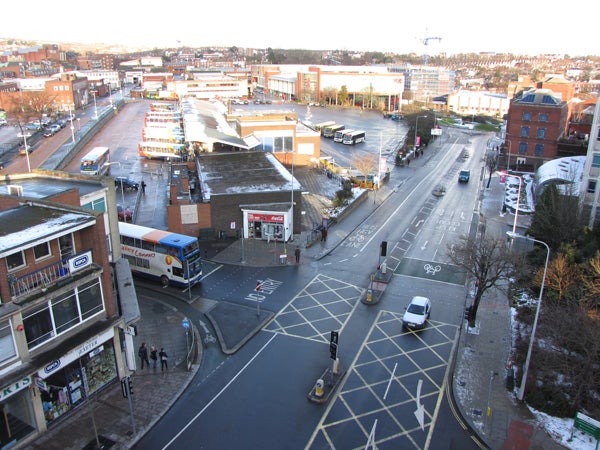
The wide-angle end is equivalent to 28mm.
—-

The 560mm-equivalent telephoto end is fantastic for zooming in on distant details, and the optical IS keeps in rock steady.
—-

The exposure meter and white balance cope well with unusual conditions.
—-

Figures on a white background are an exposure nightmare, especially when it’s a crowd of children running about and throwing snowballs, but the SX1 coped excellently.
—-
Trusted Score
Score in detail
-
Value 7
-
Image Quality 8
-
Build Quality 9
Features
| Camera type | Digital Compact |
| Megapixels (Megapixel) | 10 Megapixel |
| Optical Zoom (Times) | 20x |

